Minutes away from Fermilab’s particle accelerators, the lab’s iconic bison herd welcomes its newest (and most adorable) member. The first calf this spring was born on April 13; mom and baby both are doing well.
The newest calf brings the herd to 40 animals, joining 24 cows, two bulls and 13 yearlings. “This year we have more than usual because we kept more calves from last year,” said Cleo Garcia, Fermilab’s bison herdsman. Normally, calves are sold in the fall after they’ve been weaned, but last year, 11 were not purchased, and two calves arrived so late in the season that they were still nursing.
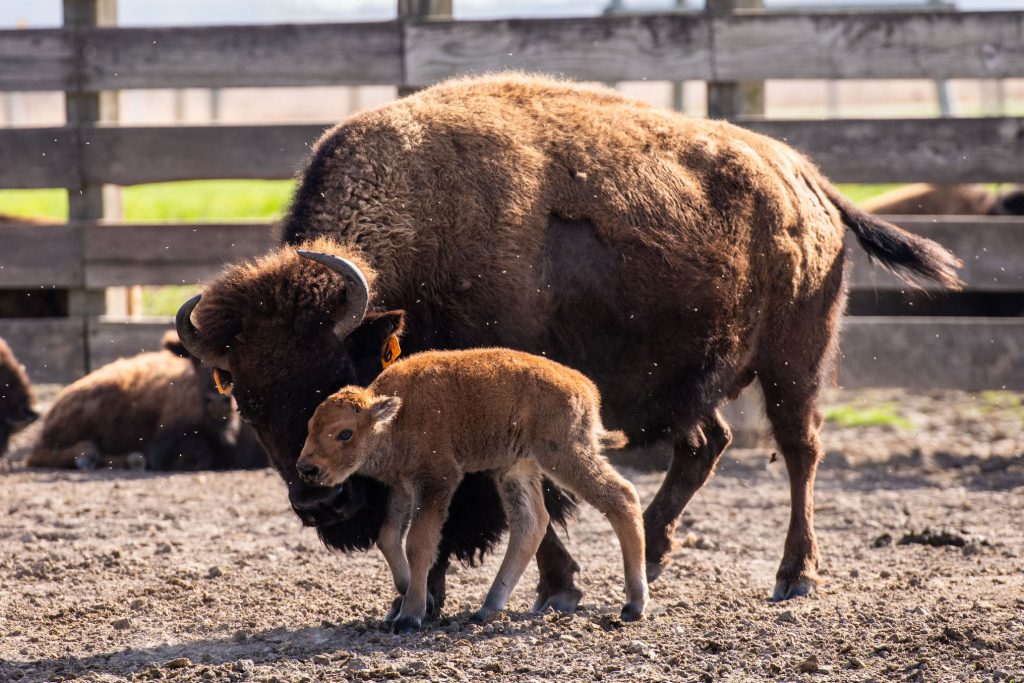
Fermilab’s first calf was born April 13, marking the start of the new calf season this spring. Photo: Ryan Postel, Fermilab
Bison have been living on the natural areas of Fermilab since 1969 when the lab’s first director, Robert Wilson, established the herd to connect the lab with the Midwestern prairie on which it’s built. The herd started with a single bull, two cows and three yearlings — all introduced with lively personas — and another 12 animals were donated by the Illinois Department of Conservation in 1971 to help diversify the stock.
Most of the Fermilab bison today are descendants of this original herd. “All the cows were born here at Fermilab,” Garcia said, “the only thing we change is the bulls every five to six years.” Rotating the bulls keeps the herd healthy and genetically diverse. In fact, genetic testing in 2015 revealed that the Fermilab herd is 100% bison, free of cattle genes, and shares lineages with wild herds in six other states.
“We hope to have at least 22 calves this year,” said Garcia. Determining exactly how many calves to expect annually is an imprecise science because the grounds team lets everything happen naturally. Rather than testing the cows to see if they’re pregnant, the team must rely on physical signs like swollen udders and bellies for an estimate. “You can see when they’re about to give birth,” Garcia said, “Most of them tend to get away from the rest of the herd, and then they come back with a baby. It’s amazing.”

The newest member of Fermilab’s bison herd was born on an 80-degree Fahrenheit spring day, the same day the lab celebrated the opening of two new research buildings and the groundbreaking of the Linac Complex. Photo: Ryan Postel, Fermilab
Calving season is expected to continue through July, and perhaps a bit longer; the final calf of last year’s season was born in September. As more calves arrive, the grounds team will be on the lookout to ensure they are thriving. “We’re looking for signs that calves are nursing,” explained Garcia, “and that they are welcomed by the herd.” And sometimes, the team must chase coyotes from the pens. Although a single coyote doesn’t present a danger to the bison, Garcia said they don’t want to risk a whole pack taking an interest.
For those visiting the herd, Garcia suggested coming to Fermilab public areas multiple times throughout the season to see the color of the calves change from a light cinnamon to a dark brown. And of course, keeping an eye out for playful newborns. “They play sometimes,” Garcia said, “You see them running around and start jumping, especially after nursing.”
The Fermilab site has been designated a National Environmental Research Park by the U.S. Department of Energy. The lab’s environmental stewardship efforts are supported by the Department of Energy Office of Science as well as Fermilab Natural Areas.
Fermilab is supported by the Office of Science of the U.S. Department of Energy. The Office of Science is the single largest supporter of basic research in the physical sciences in the United States and is working to address some of the most pressing challenges of our time. For more information, visit Fermilab’s website and follow us on Twitter at @Fermilab.
Gov. Pritzker and other local legislators joined DOE officials at Fermilab in Batavia, Illinois, for the opening of two new buildings and the groundbreaking of another to usher in a new era of science.
The U.S. Department of Energy’s Fermi National Accelerator Laboratory celebrated three important construction milestones yesterday that will increase the lab’s research efficiencies and capabilities. In attendance at the “Building Fermilab’s Future” ceremony in Batavia were representatives from the DOE Office of Science, Illinois Gov. J.B. Pritzker and local officials, including U.S. Reps. Sean Casten and Bill Foster, and national and international partners and collaborators.

Gov. J.B. Pritzker addressed the audience at Fermilab’s “Building Fermilab’s Future” event while University of Chicago President Paul Alivisatos (back left) and Fermilab Director Lia Merminga (back right) look on. Photo: Ryan Postel, Fermilab
“We don’t know that we’re witnessing history until, frankly, it is in the rear-view mirror. But with Fermilab, we get to celebrate discovery and innovation in real time, right now,” said Gov. J.B. Pritzker.
The brand-new, 80,000-square-foot Integrated Engineering Research Center (IERC), located next to the iconic Wilson Hall, will provide state-of-the-art lab space, making research and development a more collaborative and centralized process. It will be the new home of engineers and technicians working on high-energy physics projects, like the international Deep Underground Neutrino Experiment led by Fermilab and the proposed next-generation cosmic microwave background project called CMB-S4. It will also enable cutting-edge engineering for emerging technologies, including quantum and microelectronics.
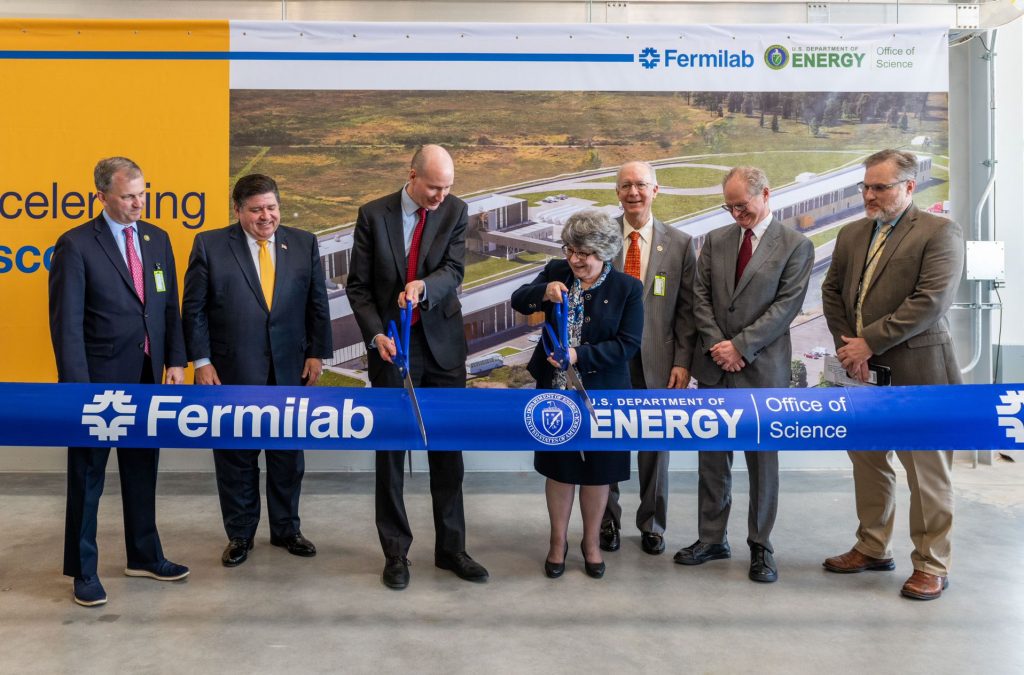
U.S. Reps. Sean Casten (far left) and Bill Foster (back, third right) joined the ribbon-cutting of Fermilab’s PIP-II cryoplant building with Gov. J.B. Pritzker (second left), Deputy Secretary of Energy David Turk (center left), Fermilab Director Lia Merminga (center right), University of Chicago President Paul Alivisatos (second from right) and Fermi Site Office Manager Roger Snyder (far right). Photo: Ryan Postel
Fermilab Director Lia Merminga welcomed all who attended, adding, “The completion of two buildings and the start of the PIP-II Linac Complex are major steps toward transforming our lab’s physical and scientific/engineering landscape. The new IERC and the PIP-II Cryoplant buildings will be centers of excellence for research, innovation and collaboration that will accelerate the science of DUNE and a rich array of discoveries.”
The new PIP-II Cryogenic Plant Building was also opened at today’s event. It will house a cryogenic plant, which is an in-kind contribution from the Department of Atomic Energy, India, to provide the PIP-II accelerator with liquid helium to cool superconducting radio-frequency modules for particle acceleration. PIP-II is an essential enhancement to the Fermilab particle accelerator complex that will power beamline-based experiments at Fermilab. Its new 215-meter linear accelerator, or linac, will eventually power the high-energy neutrino beam that will send neutrinos through the earth toward the international DUNE project in Lead, South Dakota. PIP-II is the first U.S. accelerator project to be built with significant international contributions.
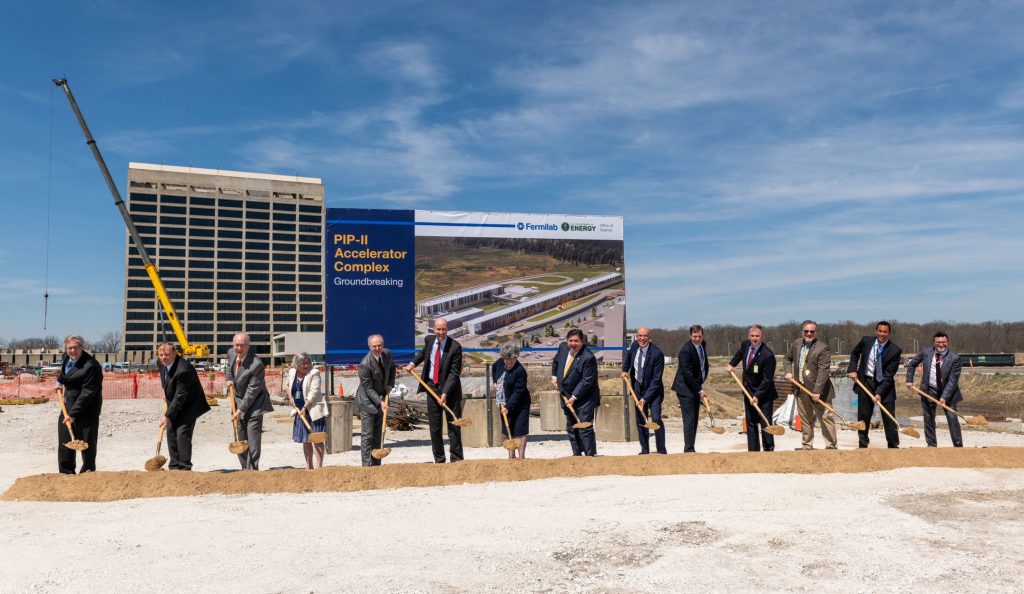
Fermilab had the ceremonial groundbreaking of the PIP-II Accelerator Complex with representatives from the DOE Office of Science, Illinois Gov. J.B. Pritzker and local officials, including U.S. Reps. Sean Casten and Bill Foster, and national and international partners and collaborators.
Photo: Ryan Postel, Fermilab
The groundbreaking today for the Linac Complex for the PIP-II accelerator kicks off the construction of the approximately 800,000-square-foot complex that will have four components: the linac tunnel, where the linear accelerator will reside; the linac gallery that will house equipment, much of which will come from international partners as in-kind contributions; the high bay building, where the loading dock and room-temperature front end of the linac will be located; and a beam transfer line. The entire construction project is expected to take approximately 39 months.
Fermilab is located on 6,800 acres of prairie land in Batavia, Illinois, a Chicago suburb. The area selected for the PIP-II site minimizes the impact on the prairie, which Fermilab maintains. The site resides along Fermilab’s Main Ring Road, where contractors can work without interrupting other operations of the lab.
The construction of the Integrated Engineering Research Center was funded by the Science Laboratory Infrastructure program within the Department of Energy Office of Science.
Fermi National Accelerator Laboratory is supported by the Office of Science of the U.S. Department of Energy. The Office of Science is the single largest supporter of basic research in the physical sciences in the United States and is working to address some of the most pressing challenges of our time. For more information, please visit science.energy.gov or at www.fnal.gov and follow us on Twitter at @Fermilab.
The Integrated Engineering Research Center at the U.S. Department of Energy’s Fermi National Accelerator Laboratory is about to become the place to tackle the technical challenges of particle physics experiments. It will be the new home of engineers and technicians working on high-energy physics projects, like the Fermilab-hosted Deep Underground Neutrino Experiment and the proposed next-generation cosmic microwave background project called CMB-S4.
The brand-new, 80,000-square-foot building provides space for research, design, construction and testing of technologies. It will host state-of-the-art infrastructure for the development of technologies for particle detectors, including electronics and application-specific integrated circuits. And it was built to kindle innovation across the lab.
“To me, the most important thing is getting a lot of people together and no longer spread out all over the Fermilab site,” said Leo Bellantoni, a senior scientist at Fermilab working on the project. “It’s going to be a great facility for getting stuff launched.”

The brand-new, 80,000-square-foot Integrated Engineering Research Center provides space for research, design, construction and testing of technologies for particle physics research at Fermilab. Photo: Ryan Postel, Fermilab
Centrally located next to Fermilab’s iconic, 16-story Wilson Hall, the sustainably built center has two floors, with lab space on the ground floor and office and conference space on the second. Two of these labs will provide much-needed space dedicated to DUNE-related work — one cold lab for work with cryogenic liquids, and one warm lab for non-cryogenic work. These new labs will provide space for DUNE engineers and scientists to develop and test modules for neutrino detectors while streamlining workflows and providing opportunities for more collaboration.
“One of the draws of bringing people to Fermilab is having the facilities that would be difficult for them to have of similar scale or complexity at their university,” said Jen Raaf, a senior scientist working on DUNE. “So having things like this will definitely draw more people to come here, which feeds into this nice environment where you get to talk to people from different backgrounds and spark new ideas.”
One of the first DUNE projects to go into the cold lab will be work on the photon detection system for the second detector module planned for the DUNE far detector in South Dakota. This detector module will have X-ARAPUCA photon detectors on the cathode, at minus 300 kilovolts, surrounded by cryogenic liquid. This has never been done before, according to Ryan Rivera, an electrical engineer and deputy head of the Real-time Processing Systems Division. To accomplish it, engineers are testing the use of optical fiber to send power and signals to and from the detector.
“At the engineering building, we want to keep optimizing this power-and-signal-over-fiber system to get the most we can out of it, the most efficient operation,” Rivera said. “There’s implications for even the proposed far detector three. It’s a perfect time for R&D to come out of the engineering building that could be the spark for decision-making for far detector three.”
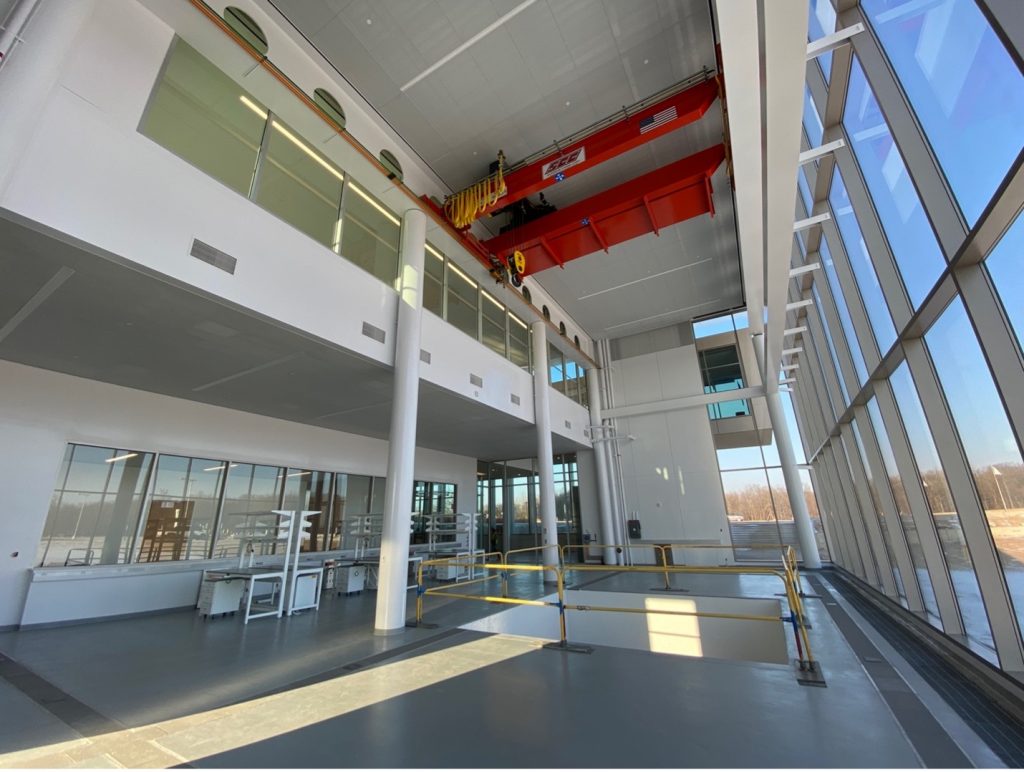
View of the DUNE Cold lab inside the IERC building, which includes a 25-ton overhead bridge crane and space for the testing of DUNE prototype detector components with liquid argon. Photo: Brian Rubik, Fermilab
In addition to DUNE, other projects and experiments will have R&D labs on the ground floor of the new building. Researchers working on CMB-S4 will use lab space for developing and testing modules and electronics for detectors that will end up as components of telescopes in the South Pole and Chile. According to Adam Anderson, a Wilson fellow and associate scientist working on CMB electronics, the new space will allow for the testing of about 500 of these modules, thanks to a new grove of dilution refrigerators.
“That’s absolutely necessary for doing this testing activity for CMB-S4 because we have so many modules that we need to test,” Anderson said. “The ability to run large numbers of cryostats is a requirement for being able to do this work.”
While the new labs for DUNE, CMB-S4 and other experimental projects moving into the new building will enhance the R&D process with more space and new equipment, the relocation will also free up cleanroom and lab space in Fermilab’s Silicon Detector Facility. The reclaimed space will become available for the testing and mass production of detector components for the high-luminosity upgrades of the CMS experiment at the Large Hadron Collider.
Perhaps most importantly, the Integrated Engineering Research Center, which was funded by the Science Laboratory Infrastructure program within DOE’s Office of Science, will allow for more scientific collaboration between scientists, engineers and technicians. It will bring together engineers and scientists who have worked on related topics in locations spread out across the 6,800-acre Fermilab site. For Rivera’s work on DUNE, for example, this will mean more frequent interactions with scientists in Wilson Hall to keep everyone involved on the same page.
“It’ll be the first time at such a large scale all this research can be happening doors away from each other,” he said. “So, there’s a lot of unpredictable synergy that can happen.”

Future research on charge-coupled devices, which scientists use to detect photons, will take place in the CCD lab on the ground floor of IERC. This lab is an example of the typical high-bay space that the building provides. The infrastructure in these spaces provides clean power, grounding bars, compressed air, nitrogen and vacuum hook-ups. Photo: Dan Fograse, Fermilab
These interactions can also be facilitated more easily for scientists and engineers working on astrophysics experiments, according to Anderson. By moving closer to Wilson Hall, he hopes for increased communication between experimentalists and theorists, which in turn can yield more scientific developments from collaborations.
“People who are primarily working in Wilson Hall in astrophysics, like the theory people, also express that they find it interesting to be closer to the experimental work,” he said. “They learn something from us as much as we learn from them.”
According to Bellantoni, the benefits of being near Wilson Hall and in the same building also go beyond just scientific developments. Bringing people closer together not only helps the scientific process but fosters community as well.
“All the labs have big windows, and people are going to walk by and look in and maybe be curious about what their coworkers are doing,” he said. “Just having people in the same space is a tremendous benefit.”
The construction of the Integrated Engineering Research Center was funded by the Science Laboratory Infrastructure program within the Department of Energy Office of Science.
Fermi National Accelerator Laboratory is supported by the Office of Science of the U.S. Department of Energy. The Office of Science is the single largest supporter of basic research in the physical sciences in the United States and is working to address some of the most pressing challenges of our time. For more information, please visit science.energy.gov.
In recent months, the neutrino research facility at the European laboratory CERN has been bustling with activity. Scientists, engineers and technicians from around the world have gathered there to assemble a large prototype of a new particle detector to study the neutrino, one of the most mysterious types of particles in the universe.
Neutrinos are everywhere, but they rarely interact with matter. Each second, trillions of these particles traverse our bodies and leave without a trace. By studying these ghost-like particles, physicists hope to answer questions, such as: Why is the universe made of matter? What is the relationship between the four forces of nature? How are black holes formed in the aftermath of an exploding star?
Researchers working on the international Deep Underground Neutrino Experiment, hosted by the U.S. Department of Energy’s Fermi National Accelerator Laboratory, hope to solve these mysteries. Their work on the prototype detector at CERN brings them a step closer to achieving this goal.
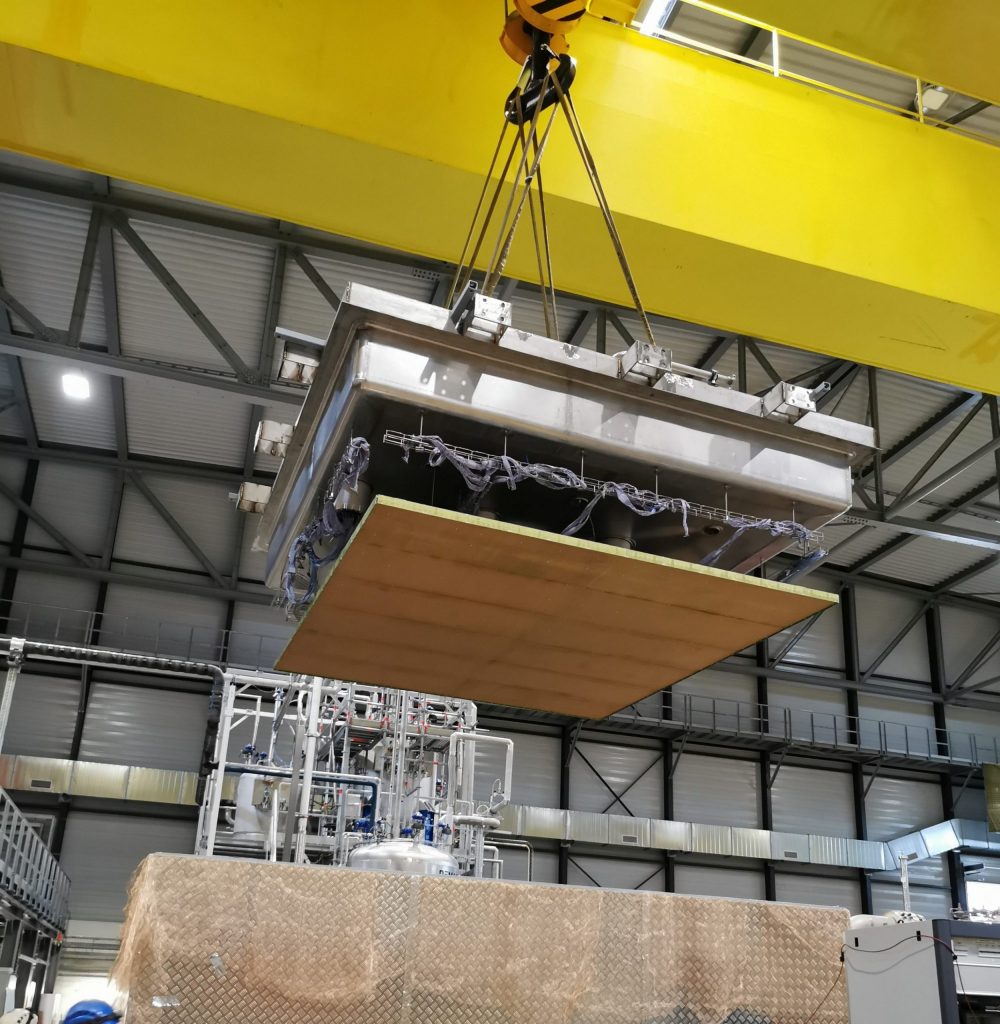
A crane lowers a charge readout plane attached to the top of the cryogenic vessel onto the vessel. Photo: DUNE collaboration
The infrastructure needed for DUNE is expansive. It includes a new particle accelerator at Fermilab, which will produce a neutrino beam that will pass through 1,300 kilometers of earth before reaching the Sanford Underground Research Facility in South Dakota. At SURF, these particles will be greeted by the DUNE far detector, a gigantic subterranean detector housed 1.5 kilometers below the surface. The detector will comprise huge detector modules containing argon, an element whose highly stable nature makes it perfect for studying neutrinos. Excavation of the underground caverns for the DUNE far detector is about 60% complete.
Testing new technology
Members of the DUNE collaboration, which includes scientists and engineers from more than 35 countries, are busy at work designing, testing and building the components of the first two DUNE detector modules to be installed at SURF. Module one will be a horizontal drift detector, which is based on a tried-and-tested technique that will be scaled up for DUNE. The mass production of components for this first module already has begun. The second module, known as the vertical drift detector, will feature new technology. Testing has been ongoing for the last two years.
“I expect exciting physics out of both the horizontal and vertical drift detectors,” said Steve Kettell, the technical coordinator for the vertical drift detector, based at the DOE’s Brookhaven National Laboratory. “But the vertical drift technology opens up significant opportunities for building additional detectors that are lower in cost and easier to install.”
Horizontal vs. vertical
On a basic level, horizontal and vertical drift detectors work in the same way. When a neutrino interacts with an argon atom inside the detector’s liquid-argon-filled chamber, the particles produced in this interaction release electrons. A strong electric field between opposite sides of the detector chamber pushes these loose electrons to an anode, a large structure that detects the arrival of charged particles. In a horizontal drift detector, the electric field exists between two opposing walls, and the electrons drift horizontally; in a vertical drift detector, the electric field runs between the bottom and top of the detector, and the electrons drift vertically. The argon-neutrino interaction also produces a brief flash of light that both detectors capture with a separate photon detection system.
“Fundamentally, there’s nothing different about vertical drift and horizontal drift,” Kettell explained. “We are detecting neutrino events in essentially the same manner.”
The differences are in the details. The anode of the horizontal drift detector consists of large planes of tightly wound wires, known as anode plane assemblies, or APAs. They are 6 meters tall and 2.3 meters wide. The anode of the vertical drift detector, on the other hand, will be composed of charge readout planes, or CRPs. They are large, perforated-printed circuit boards that are 3 meters by 3.5 meters in size and have copper strips printed onto their surfaces. Like the wires in the APAs, the copper strips in the CRPs will collect the drifting electrons.

A close-up of the charge readout planes for the DUNE vertical drift detector. Photo: DUNE collaboration
The DUNE vertical drift detector will feature multilayer CRPs at the top and at the bottom. “The CRPs have perforated 2.5-millimeter holes, so that electric charge can pass through and go to another layer to get collected,” said Dominique Duchesneau, leader of the CRP consortium and a physicist at the French National Centre for Scientific Research. Each CRP layer has differently orientated copper strips, he added, which “gives you the possibility to have multiple views of the electrons.”
A key advantage of CRPs is that because they are made of simple metal-plated circuit boards rather than a tight coil of wires, they are cheaper and easier to manufacture and install than APAs.
“With the vertical drift detector, we’re trying to demonstrate that we can build a less expensive detector that works equally well,” Kettell said.
Because the vertical drift detector technology requires fewer elements than the horizontal drift, it provides a larger active volume. A larger active volume means that there will be more space in which particle interactions can be collected, said Inés Gil-Botella, a DUNE physics coordinator based at the Centre for Energy, Environmental and Technological Research in Spain. “You’re maximizing the possibility of seeing neutrino interactions in this liquid argon.”
Another innovation is the photon detection system DUNE scientists plan to build for the vertical drift detector, an upgrade of the ARAPUCA technology developed for the first DUNE far detector module. This new system will cover all four cryostat walls as well as the cathode with photon detection modules. (In contrast, in the horizontal drift detector, the photon detectors only are embedded in the APA planes, behind the wires.) To power and read out the photo sensors on the high-voltage cathode, which is set to 300 kilovolts, the vertical drift team uses a powerful laser that provides power via optical fibers.
In addition, the argon within the vertical drift detector will be doped with xenon to enhance the number of photons that get detected when particles interact with atoms in the liquid —and to enhance the uniformity of light detection throughout the chamber. Together, these features will make this photon detection system more capable of detecting low-energy physics events, such as those triggered by supernovae or solar neutrino events, Gil-Botella said.
A bustle of activity

This newly designed high-voltage extender helps create a 300,000-volt electric field between the top and bottom of the vertical drift prototype detector. Photo: DUNE collaboration
The team working on the DUNE vertical drift detector comes from around the world. Major contributions are being made by CERN, France, Italy, Spain and the U.S. But members also come from several other countries in Europe, Asia and Latin America. “There’s been tremendous progress on many fronts,” said Kettell.
This group has been busy. To date, they have successfully tested small-scale, 32-centimeter-by-32-centimeter CRPs in a 50-liter liquid-argon-filled chamber fitted with a cathode, electronics and a photon detection system. This early prototype was able to collect data from cosmic-ray tracks with “good signal-to-noise performance,” said Kettell. They have also tested full-size, 3-meter by 3.5-meter CRPs with the cathode, electronics, and the photon detection system in a large coldbox at CERN.
The team has demonstrated that the components of the vertical drift detector could read out signals at 300 kilovolts — the high voltage that will be needed for creating the electric field in the full-sized DUNE detector. They have also shown that electrons can drift six meters — the maximum distance electrons will travel in the final-size module — and use the CRPs to receive these tracks. “The next big milestone we’ll face is the installation of all of the systems together at a larger scale,” Gil-Botella said.
The team is now assembling parts into a larger vertical drift prototype, dubbed “vertical drift module-0,” in a large cryogenic vessel at CERN, about the size of a small house. This prototype will contain two full-sized CRPs on both the top and bottom of the detector, with the cathode installed in the middle, as well as an advanced photon detection system. Electrons knocked loose in the upper half of the detector will drift upward toward the CRP set at the top, and electrons produced in the lower half will drift in the down direction, until they reach the CRP layers at the bottom. CRP development has been led by France and CERN, with the construction of the top CRPs at CERN and the bottom CRPs in the U.S.
The DUNE researchers aim to complete the installation of the vertical drift prototype detector in spring 2023. Once all systems have been tested, the team will fill the detector with liquid argon and turn it on, so that scientists can observe the tracks left by particle beams and cosmic rays that pass through it.
Ultimately, the goal is to have the components of the vertical drift detector ready to be installed in one of the large caverns in South Dakota in 2027.
“What I really would like to see is the installation of the first CRPs in the big cryostat at SURF, which will come in several years,” Duchesneau said. “In the meantime, I think module-0 running and taking data in the real configuration of the vertical drift is a very exciting step.”
Fermi National Accelerator Laboratory is supported by the Office of Science of the U.S. Department of Energy. The Office of Science is the single largest supporter of basic research in the physical sciences in the United States and is working to address some of the most pressing challenges of our time. For more information, please visit science.energy.gov.
Preparations for the construction of the first detector module of the Deep Underground Neutrino Experiment are rapidly progressing. Members of the international DUNE collaboration have begun the final tests of detector components that will be shipped to South Dakota. There they will become part of a one-of-a-kind experiment designed to study some of the most elusive particles in the universe: neutrinos.
DUNE is an experiment aimed at exploring the nature of neutrinos. Scientists hope that unlocking the secrets of these particles will shed light on some of the biggest mysteries in physics, such as why the universe is made of matter and how neutron stars and black holes are forged in the aftermath of exploding stars.
DUNE, hosted by the U.S. Department of Energy’s Fermi National Accelerator Laboratory, will be housed at two locations: the Fermilab site in Illinois and the Sanford Underground Research Facility in South Dakota. The far detector, an enormous structure envisioned to ultimately comprise four modules, will be located 1.5 kilometers underground at SURF. Each module will be a liquid-argon time projection chamber, or LArTPC, designed to be filled with 17,000 tons of argon, an element commonly found in air that is ideal for studying neutrinos.

The construction of wire planes, called anode plane assemblies, is underway at Daresbury Laboratory in the U.K. The laboratory will ship 136 APAs to South Dakota for the Deep Underground Neutrino Experiment. Photo: DUNE collaboration
The first DUNE detector module to be built at SURF will employ horizontal drift technology. When neutrinos collide with the argon atoms inside the module, they will produce charged particles. These charged particles knock out electrons as they travel through the argon. The electrons are attracted by a strong electric field towards anode plane assemblies, or APAs, which record a projection of where the electrons were produced. By measuring the timing of when electrons hit the APAs, scientists are able to reconstruct three-dimensional particle tracks.
When complete, the first detector module will contain 150 APAs, each a large rectangular plane approximately 2.3 meters by 6 meters in size and composed of tightly wound copper-beryllium wires. “We are going to effectively plaster a wall with a grid of wires,” said Justin Evans, a professor of physics at the University of Manchester. He is leading the effort to build APAs in the U.K.
The technology for the first module was successfully tested in a scaled-down version called ProtoDUNE at the CERN Neutrino Platform in 2019. Although it was only one-twentieth of the size to the final DUNE detector module, it still was the largest LArTPC ever constructed and operated.
“That was the first time that we in the U.K. built any of these wire grids and took data from them,” said Evans. “And they worked wonderfully.”
In addition to proving that the detector technology would work, the horizontal drift prototype revealed where design improvements could be made. With this in mind, scientists designed ProtoDUNE II, an upgraded prototype that will undergo tests at CERN this year.
“With a prototype, there’s always lessons learned,” said Thomas Wieber, the installation team leader at CERN. “We want to prove that what we think is going to work better actually does work better.”
DUNE scientists are also working on developing the technology for a vertical drift detector, which is the planned technology for the second far detector module. Preparations for testing the new technology in a separate prototype detector, known as vertical drift module-0, are underway at CERN as well.
Testing the full assembly process
Testing all aspects of the horizontal drift module assembly also involves ensuring that all the detector components, which come from DUNE collaborators around the world, will arrive safely. To ensure this process goes smoothly, ProtoDUNE II also has served as a testbed for the installation process. The groups involved in manufacturing the detector components brought all their test parts together at CERN to assemble and test the prototype.
“We have had collaborators coming in from all over the world,” said Daniela Macina, the installation coordinator for the horizontal drift detector at CERN. “This is the first time we’ve integrated and installed the final DUNE horizontal drift detectors all together.”
ProtoDUNE II contains four APAs. All four were tested in a cold box filled with super-cold gaseous nitrogen in order to ensure that the electronics function properly at frigid temperatures. All four APAs passed the test. They then were assembled in the ProtoDUNE II cryostat, along with other parts of the prototype. These parts include the electronics and light sensors, which identify photons that are released when neutrinos interact with the liquid argon in the detector.

The DUNE collaboration has finished the assembly of their large horizontal drift prototype detector, known as ProtoDUNE II, at CERN. It is the final test before ramping up mass production of DUNE detector components. Photo: DUNE collaboration
“We needed to assemble things according to a procedure that will be as close as possible to the one we’ll use in South Dakota,” Macina said.
Later this year, the team will fill ProtoDUNE II with liquid argon and shoot a beam of particles through the detector to test it. “We don’t expect big surprises, because there were only minor changes between ProtoDUNE and ProtoDUNE II,” said Macina.
As the final work on ProtoDUNE II takes place at CERN, scientists are also ramping up production of the APAs that will be installed at SURF. Of the 150 APAs that will be installed in the first module of the far detector, 136 APAs will be produced at the Daresbury Laboratory in the U.K., and another 14 will be produced at the University of Chicago.
To support the mass production of these parts, the Daresbury Laboratory in the U.K. has constructed an APA factory where the team has set up four production lines, each with six-meter-long machines for winding the wires around steel frames to create the APAs.
“We have four of those set up, all working in parallel,” Evans said. “We’re trying to get to the point where each production line can produce one APA every two months.”
Shipping detector components to South Dakota
Activities related to the detector installation have also started up in South Dakota, where the excavation of the caverns for the DUNE far detector are about 60% complete. In early November, the team shipped one of the APAs from the first prototype at CERN to SURF for a logistics test. The process of transporting the long, rectangular APA from Europe to the United States, offloading the structure, then lowering it a mile below the ground through a relatively narrow mineshaft was successfully completed.
“We’re using older APAs to validate those procedures so that we’re not going to damage anything when we start bringing the real APAs to SURF,” said Fermilab scientist Eric James, a technical coordinator who focuses on DUNE’s horizontal drift detector.
Despite all the details that need to be worked out to bring the first DUNE detector module to life, DUNE scientists are not losing sight of their ultimate goal: exploring a new frontier of neutrino science.
“I’m hugely excited about what we will see when we switch this thing on,” Evans said. “There is so much the neutrino can tell us about the universe.”
Fermi National Accelerator Laboratory is supported by the Office of Science of the U.S. Department of Energy. The Office of Science is the single largest supporter of basic research in the physical sciences in the United States and is working to address some of the most pressing challenges of our time. For more information, please visit science.energy.gov.

Fermilab Deputy Director Bonnie Fleming, chair of the DUNE Resources Review Board. Credit: Fermilab
On March 30 and 31, representatives from science funding agencies around the world will meet in Lead, South Dakota, to view the progress on the Deep Underground Neutrino Experiment, an international experiment hosted by the U.S. Department of Energy’s Fermi National Accelerator Laboratory.
The funding agency representatives are members of the DUNE Resources Review Board, a group of about 40 people who provide oversight of DUNE and coordination among funding agencies. They meet three times a year. This is their first meeting in Lead, South Dakota.
More than 1,400 scientists and engineers across 200 institutions in over 35 countries collaborate on DUNE to decipher the secrets of the neutrino.
“The RRB helps facilitate a strong partnership between the member countries of DUNE,” said Fermilab Deputy Director Bonnie Fleming, chair of the RRB. “DUNE is bringing together many different countries to construct a very large and complicated experiment. This requires close coordination between all these partners.”
The DUNE collaboration focuses on studying subatomic particles known as neutrinos. They may hold the answers to some of the biggest open questions in physics, such as why our universe is made of matter and how neutron stars and black holes are formed.
Construction has begun on DUNE particle detector components as well as the Long-Baseline Neutrino Facility, which will provide the space, infrastructure, and neutrino beam for the experiment. Fermilab, located in Illinois, will house the DUNE near detector and provide the particle beam. The neutrinos will travel 1,300 kilometers (800 miles) straight through Earth to the Sanford Underground Research Facility in South Dakota. There the DUNE far detector —located 1.5 kilometers (about a mile) below the surface — will catch neutrinos and unveil their mysterious behavior.
“Typically, the RRB meetings are held at Fermilab,” Fleming said. “We wanted to take the opportunity to bring the RRB members to SURF to let them see the facility and the place where the DUNE far detector will be.”
At SURF, the excavation of the huge underground complex for LBNF is about 60% complete. Construction crews have been hard at work carving out the extensive network of tunnels and caverns, which will cover about the size of eight soccer fields when complete. Two of the three caverns will be about 28 meters (92 feet) tall. They will provide space for four enormous detector modules that will be filled with a total of 70,000 tons of liquid argon, a highly stable element ideal for studying neutrino interactions.

Excavation of the tunnels and three large caverns for the DUNE detector in South Dakota is more than halfway complete. Credit: Photo: Matthew Kapust, Sanford Underground Research Facility
Work on components for the first two detector modules is moving forward at a rapid pace. DUNE members around the world have been busy building and testing prototypes of the underlying detector technology. The mass production of components for the first detector module has begun. They will be shipped to SURF and lowered underground. In the caverns, they will be assembled piece by piece — in a manner akin to putting together a ship in a bottle.
“The excavation is going beyond expectation, paralleled by similar progress in the testing and building of the far detector modules,” says DUNE co-spokesperson Sergio Bertolucci, former director of research at CERN and RRB member. “Two years from now, SURF will see a team of enthused engineers, technicians and physicists building this big ship in a bottle.”
During the meeting, which will take a hybrid format, the RRB members will receive updates on the status of the project and coordinate tasks. RRB members joining onsite will receive a tour of the excavation site as well.
Fermi National Accelerator Laboratory is supported by the Office of Science of the U.S. Department of Energy. The Office of Science is the single largest supporter of basic research in the physical sciences in the United States and is working to address some of the most pressing challenges of our time. For more information, please visit science.energy.gov.
